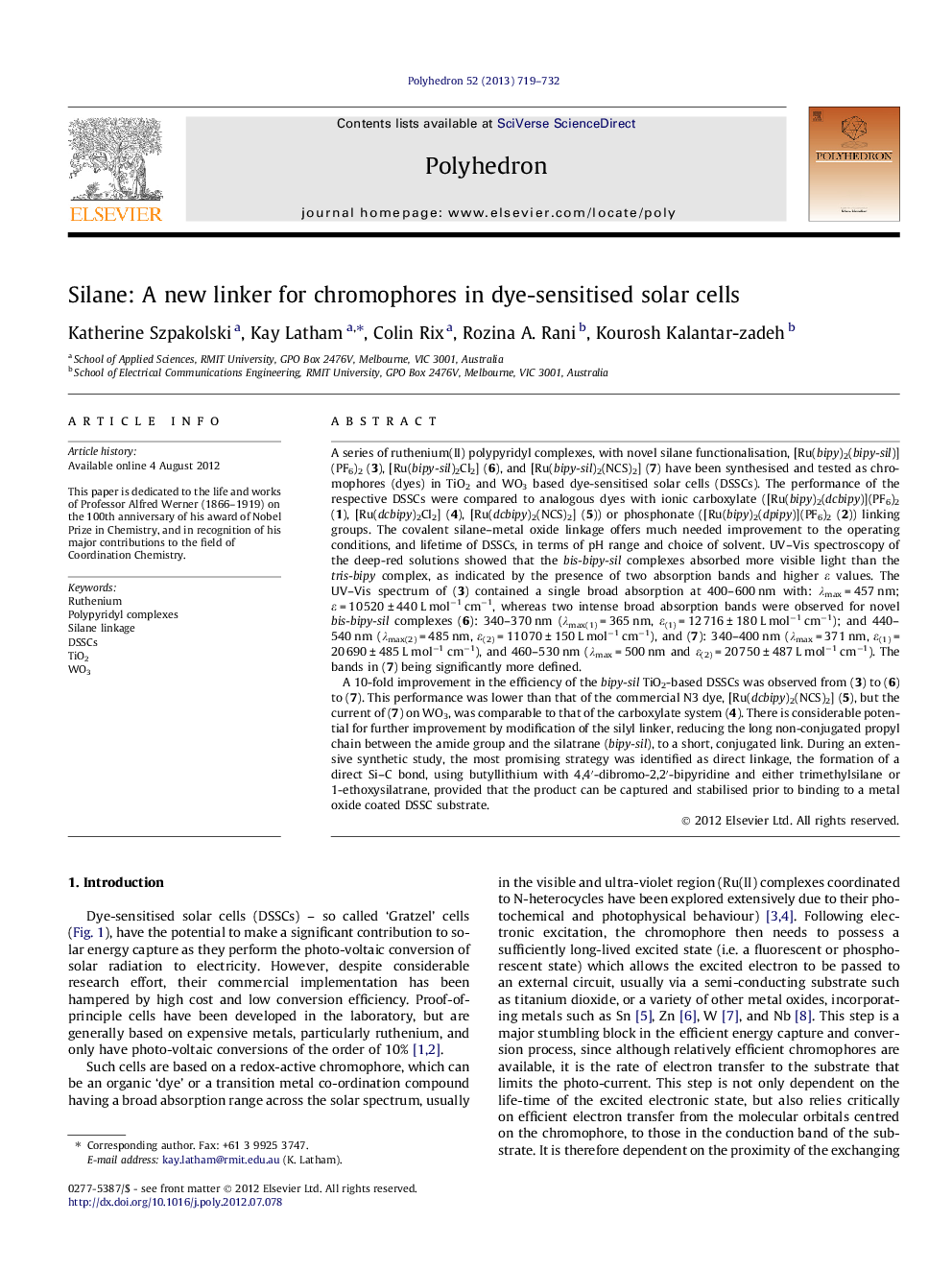| Article ID | Journal | Published Year | Pages | File Type |
|---|---|---|---|---|
| 1337004 | Polyhedron | 2013 | 14 Pages |
A series of ruthenium(II) polypyridyl complexes, with novel silane functionalisation, [Ru(bipy)2(bipy-sil)](PF6)2 (3), [Ru(bipy-sil)2Cl2] (6), and [Ru(bipy-sil)2(NCS)2] (7) have been synthesised and tested as chromophores (dyes) in TiO2 and WO3 based dye-sensitised solar cells (DSSCs). The performance of the respective DSSCs were compared to analogous dyes with ionic carboxylate ([Ru(bipy)2(dcbipy)](PF6)2 (1), [Ru(dcbipy)2Cl2] (4), [Ru(dcbipy)2(NCS)2] (5)) or phosphonate ([Ru(bipy)2(dpipy)](PF6)2 (2)) linking groups. The covalent silane–metal oxide linkage offers much needed improvement to the operating conditions, and lifetime of DSSCs, in terms of pH range and choice of solvent. UV–Vis spectroscopy of the deep-red solutions showed that the bis-bipy-sil complexes absorbed more visible light than the tris-bipy complex, as indicated by the presence of two absorption bands and higher ε values. The UV–Vis spectrum of (3) contained a single broad absorption at 400–600 nm with: λmax = 457 nm; ε = 10 520 ± 440 L mol−1 cm−1, whereas two intense broad absorption bands were observed for novel bis-bipy-sil complexes (6): 340–370 nm (λmax(1) = 365 nm, ε(1) = 12 716 ± 180 L mol−1 cm−1); and 440–540 nm (λmax(2) = 485 nm, ε(2) = 11 070 ± 150 L mol−1 cm−1), and (7): 340–400 nm (λmax = 371 nm, ε(1) = 20 690 ± 485 L mol−1 cm−1), and 460–530 nm (λmax = 500 nm and ε(2) = 20 750 ± 487 L mol−1 cm−1). The bands in (7) being significantly more defined.A 10-fold improvement in the efficiency of the bipy-sil TiO2-based DSSCs was observed from (3) to (6) to (7). This performance was lower than that of the commercial N3 dye, [Ru(dcbipy)2(NCS)2] (5), but the current of (7) on WO3, was comparable to that of the carboxylate system (4). There is considerable potential for further improvement by modification of the silyl linker, reducing the long non-conjugated propyl chain between the amide group and the silatrane (bipy-sil), to a short, conjugated link. During an extensive synthetic study, the most promising strategy was identified as direct linkage, the formation of a direct Si–C bond, using butyllithium with 4,4′-dibromo-2,2′-bipyridine and either trimethylsilane or 1-ethoxysilatrane, provided that the product can be captured and stabilised prior to binding to a metal oxide coated DSSC substrate.
Graphical abstractA series of Ru(II) polypyridyl complexes, with novel silane functionalisation (bipy-sil), have been synthesised and tested as chromophores in TiO2 and WO3 based dye-sensitized solar cells (DSSCs). Covalent silane - metal oxide linkage offers much needed improvement to the operating conditions of DSSCs, than current ionic linkers. A 10-fold improvement in the efficiency of the bipy-sil TiO2-based DSSCs was observed from [Ru(bipy)2(bipy-sil)](PF6)2 to [Ru(bipy-sil)2Cl2] to [Ru(bipy-sil)2(NCS)2]. Current of [Ru(bipy-sil)2(NCS)2] on WO3 comparable to carboxylate systems. Further efficiency increases by reducing the long non-conjugated link to a short, conjugated Si-C link.Figure optionsDownload full-size imageDownload as PowerPoint slideHighlights► A series of Ru(II) polypyridyl complexes with novel silane substitution (bipy-sil) were prepared. ► These were tested as ‘dyes’ in TiO2 and WO3 based dye-sensitized solar cells (DSSCs). ► The silane linkage is more stable to pH and solvent type than traditional linkers eg. COOH, PO3H. ► Current density (IOC) of [Ru(bipy-sil)2(NCS)2 on WO3 comparable to current COOH dye systems. ► Further efficiency increases using a conjugated, shorter or direct Si-C linker.
